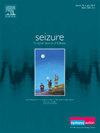儿童癫痫、呼吸障碍与轻微心电图异常之间的关系
IF 2.7
3区 医学
Q2 CLINICAL NEUROLOGY
引用次数: 0
摘要
目的我们试图研究急性癫痫发作和呼吸紊乱对心电图(ECG)上反映的心电特性的影响;并分析它们与儿童癫痫诊断之间的潜在相互作用。方法急诊中心(EC)在 2011 年 1 月至 2013 年 12 月期间对有癫痫发作或癫痫诊断代码的就诊者进行了检查,如果他们在就诊后 24 小时内有心电图,则将其纳入检查范围。如果患者之前患有心脏病、离子通道病变或正在服用特定的心脏病药物,则排除在外。对照受试者的年龄和性别均为 1:1。异常心电图的定义是心律、PR、QRS 或校正 QT 间期、QRS 轴或形态、ST 段或 T 波形态与正常标准不同。我们使用多变量逻辑回归模型确定了临床因素与异常心电图结果之间的独立关联。三百名无癫痫的儿童也有癫痫发作。与对照组(29%)和非癫痫患儿(36%)相比,癫痫患儿心电图轻微异常的发生率更高(49%)。癫痫(OR:1.61,95 %CI:1.01-2.6)、需要补充氧气(OR:3.06,95 %CI:1.45-6.44)或机械通气(OR:2.5,95 %CI:1.03-6.05)与轻微心电图异常独立相关。二次分析进一步表明,仅在癫痫组中,呼吸支持水平与心电图异常之间存在独立关联。意义增加呼吸支持与轻微心电图异常之间的独立关联表明,呼吸系统对癫痫儿童的心脏有潜在影响。本文章由计算机程序翻译,如有差异,请以英文原文为准。
Associations between epilepsy, respiratory impairment, and minor ECG abnormalities in children
Objective
We sought to examine the effects of acute seizures and respiratory derangement on the cardiac electrical properties reflected on the electrocardiogram (ECG); and to analyze their potential interactions with a diagnosis of epilepsy in children.
Methods
Emergency center (EC) visits with seizure or epilepsy diagnostic codes from 1/2011–12/2013 were included if they had ECG within 24 h of EC visit. Patients were excluded if they had pre-existing cardiac conditions, ion channelopathy, or were taking specific cardiac medications. Control subjects were 1:1 age and gender matched. Abnormal ECG was defined as changes in rhythm, PR, QRS, or corrected QT intervals; QRS axis or morphology; ST segment; or T wave morphology from normal standards. We identified independent associations between clinical factors and abnormal ECG findings using multivariable logistic regression modeling.
Results
Ninety-five children with epilepsy presented to the EC with seizures, respiratory distress, and other concerns. Three hundred children without epilepsy presented with seizures. There was an increased prevalence of minor ECG abnormalities in children with epilepsy (49 %) compared to the control subjects (29 %) and those without epilepsy (36 %). Epilepsy (OR: 1.61, 95 %CI: 1.01–2.6), need for supplemental oxygen (OR 3.06, 95 % CI: 1.45–6.44) or mechanical ventilation (OR: 2.5, 95 % CI: 1.03–6.05) were independently associated with minor ECG abnormalities. Secondary analyses further demonstrated an independent association between level of respiratory support and ECG abnormalities only in the epilepsy group.
Significance
Independent association of increased respiratory support with minor ECG abnormalities suggests a potential respiratory influence on the hearts of children with epilepsy.
求助全文
通过发布文献求助,成功后即可免费获取论文全文。
去求助
来源期刊

Seizure-European Journal of Epilepsy
医学-临床神经学
CiteScore
5.60
自引率
6.70%
发文量
231
审稿时长
34 days
期刊介绍:
Seizure - European Journal of Epilepsy is an international journal owned by Epilepsy Action (the largest member led epilepsy organisation in the UK). It provides a forum for papers on all topics related to epilepsy and seizure disorders.
 求助内容:
求助内容: 应助结果提醒方式:
应助结果提醒方式:


